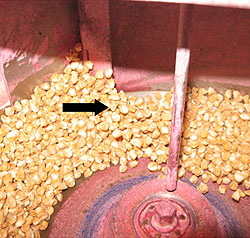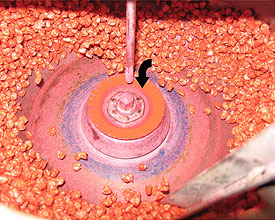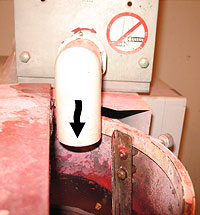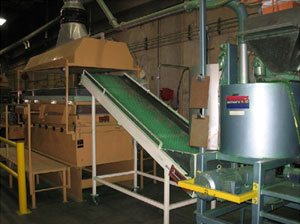AUTOMOBILES
The early
automobiles were mostly hand built one by one…a work of art.
Not many consumers could afford one. Cars ended up as toys for
the rich in the beginning. Then came Henry Ford, who figured
out how to build high quality automobiles quickly and
inexpensively using an assembly line. Car prices went down and
suddenly the common man could afford a car. The art and
craftsmanship that went into constructing one car at a time, was
no longer needed.
THE ART OF
SEED PELLETING
If you
remember the SeedTech Newsletter, “Putting Pellets Around Seed – A Science and an Art”
I explained how pelleting seed in a rolling pan involved some
art. How much adhesive to spray, how much powder to add, how
long to let the pellets roll, are all part of what pelleters
need to decide each time they pellet a new batch of seed.
Well….much like Henry Ford’s assembly line, the rotary coater
takes the art out of seed pelleting, and lowers the cost of
production. Lowering the cost to pellet seed can make it a
viable option for less expensive agronomic seed like field corn.
 HOW
A ROTARY COATER WORKS
HOW
A ROTARY COATER WORKS
Seed mixes evenly
Seed is placed
into a spinning bowl. Centrifugal force pushes the seed upward
and outward against the inside walls of the bowl. A wedge or
some other obstacle is located in front of the moving seed. The
wedge peels the seed off the wall as it spins and guides it into
the center of the bowl where centrifugal force again moves it
back to the outside. Place several of these obstacles in the
spinning bowl and you have nice mixing action. Below is a
picture of sweet corn mixing in a small rotary coater.

Add Liquid
In the center
of the spinning bowl, a small dish rotates in the opposite
direction of the bowl. Pump liquid seed treatments (or
adhesives for pelleting) down a tube directly on top of the
spinning dish. The liquid falls onto the spinning dish and is
flung outward hitting the mixing seed. Here’s a picture of the
liquid being dispersed

Add Powder
A powder
feeder is positioned on the coater dropping powder on top of the
mixing seed while the liquid adhesive is dispersed. Here’s a
picture of a powder feeder.
Continuous Batch Systems
 Seed,
liquid and powder can be measured very precisely and
automatically in a Continuous Batch System. At the push of a
button, a certain weight of seed is added to the spinning bowl,
a certain amount of liquid is added to the spinning dish, and a
certain amount of powder is added to the mixing seed. When
everything is done, the door on the spinning bowl automatically
opens and the seed is dumped onto a conveyor and to the drier to
dry. New seed automatically is dumped into the bowl to start
the process all over again. In the picture, the rotary coater
dumps onto a conveyer and over a gravity table which has been
modified to blow heated air on the moving seed to remove any
tackiness before going to the dryer to be fully dried.
Seed,
liquid and powder can be measured very precisely and
automatically in a Continuous Batch System. At the push of a
button, a certain weight of seed is added to the spinning bowl,
a certain amount of liquid is added to the spinning dish, and a
certain amount of powder is added to the mixing seed. When
everything is done, the door on the spinning bowl automatically
opens and the seed is dumped onto a conveyor and to the drier to
dry. New seed automatically is dumped into the bowl to start
the process all over again. In the picture, the rotary coater
dumps onto a conveyer and over a gravity table which has been
modified to blow heated air on the moving seed to remove any
tackiness before going to the dryer to be fully dried.
The process
becomes an assembly line that need only be monitored
periodically. What would normally take about 2 to 3 hours in a
pelleting pan may take 5 to 15 minutes in the rotary coater.
Some agronomic seed companies are starting to use the rotary
coater to increase the weight of small seeded field corn as
noted in these two articles on the subject.
Several
vegetable seed companies, seed technology companies and
greenhouses have also started to set up systems to pellet seed
using rotary coaters. Pelleting seed in a rotary coater seems
to be the wave of the future.
That’s all
for now.
If you’d
like more information on rotary
coaters check out this Web article from Incotec:
Next time
we’ll talk about “How DNA Techniques Help the Seed Industry” .
See you then.
Keith